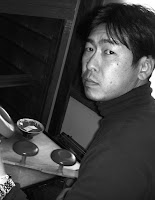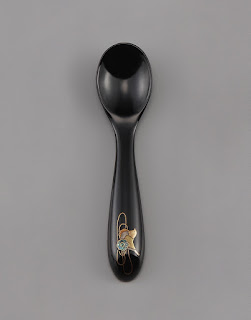Baby Spoons
When a devastating earthquake struck the Noto Peninsula in 2007, a number of lacquerware workshops were badly affected. Stock was damaged, equipment was broken and in some cases workshops and storehouses collapsed. It was a depressing time as it only added to the troubles that lacquerware makers were already confronting.
Despite being one of Japan’s most prestigious lacquerware production centres, the demand for fine items of Wajima lacquerware had been falling for sometime. Partly fuelled by rising costs, the situation was exacerbated by cheap imports and hastened by the general change in life style of the people, a trend which had been gathering pace over the past twenty to thirty years.
Something had to be done. There needed to be a focus, something to bring people together to overcome the general predicament that the lacquerware makers found themselves in.
A group of twenty makers of all ages, abilities and skills banded together. What were they to do? After long discussions and much encouragement from Yuko Yokoyama—a dedicated supporter of Japan’s traditional crafts and lacquerware in particular—it was decided to hold and exhibition in Tokyo. What were they to make? Baby Spoons.
In Japan since the eighth-century it has been a custom to celebrate when a baby’s milk teeth come through, which is generally around one-hundred days after birth. Called Okui Hajime, this custom marks a mile stone in a baby’s life. The making of a baby spoon seemed appropriate, especially as it was not only a feeding spoon but also a symbol of new life, a new beginning and the beginning of something to look forward to.
Below are the second five of the twenty Baby Spoons which were made and exhibited in Tokyo and Europe. They are an expression of something that Wajima needed. A new hope.
Junei Shioji: Flowers—Hana
This floral trio is full of meaning. Picking up on the symbolism of purity, humility and simplicity is the white rose (left). Although often translated as plume, the ume (middle) is actually a Japanese apricot—white associated with men and the red variety with women. Along with the cherry, the apricot is one of Japan’s most representative and loved flowers. The Chrysanthemum is the insignia of the Imperial Family—a symbol of dignity and strength. For Junei what these flowers symbolise is what she would hope a child is blessed with.
Akio Sakaguchi: Moon and Rabbit—Tsuki Usagi
What do you see when you look at the Moon? The Japanese see a rabbit pounding sticky rice, perhaps for a New Year celebration. The meaning is clear—peace and happiness as well as a full stomach is what we would all wish for, especially for a newborn child.
Delicately rendered maki-e work on a red background with embellishments of gold powder.
Akiko Mizutani: Let’s Eat—Itadakimasu
Akiko has achieved so much with so little. The little mouse is a piece of wit and below the little boy or girl is a hope for bonds of friendship. The bowl and chopsticks—not wanting for food of course. The shirt/blouse a hope for life’s essential clothing. A house—a place to live in safety. Work and the will to develop is symbolised by a pencil. The dove? Peace, health and the willingness to help others. And a four-leaf clover for good luck. All these things are wished for and drawn with brevity and skill.
Naomi Kamata: Carp Swimming up Stream—Nobori Koi
What an elegant design. The simplicity of this long slender spoon with its delicate depiction of a carp struggling against the flow of a river is so Japanese—ascetic and yet so rich in quality. And it gives the impression of where it is heading—the open mouth of a baby eagerly waiting for the next spoonful. The symbolism is as simple—the hope of success in life and to live with conviction.
Hiroyuki Oka: A Dove on Wheels—Hato-guruma
Like all of these spoons, the use of a toy dove signals a hope for peace and happiness—what could be more satisfying than watching a small child playing happily with a treasured toy.
Hiroyuki has rendered this toy in gold and silver powder maki-e work and chips of mother-of-pearl.
All photographs courtesy of the Wajima Urushi Tanteidan—The Wajima Lacquer Study Group
Do feel free to pass on the address of this blog to anyone you think will be interested. Or post it on a social media site. Should you wish to leave a comment, please do so by clicking on the comment mark at the bottom left of this or any of the other posts. If you have found this blog interesting, why not become a follower. Thank you.











No comments:
Post a Comment